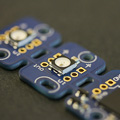Logical structure of Yoctopuce devices
![]() This week, we are continuing our series of articles for the beginners. This time, we will have a look at the logical structure of Yoctopuce devices, and how to use it. If you are a beginner, we suggest that you read this article carefully, as it will allow you to get the best from your Yoctopuce devices.
This week, we are continuing our series of articles for the beginners. This time, we will have a look at the logical structure of Yoctopuce devices, and how to use it. If you are a beginner, we suggest that you read this article carefully, as it will allow you to get the best from your Yoctopuce devices.
| No comment yet | Read more... |
Animating RGB LEDs using a Yocto-Color-V2
 When we announced the Yocto-Color-V2, we explained that this new version can drive up to 146 NeoPixel leds. However, to use this new feature, you must use a new API that we are going to discover in this post.
When we announced the Yocto-Color-V2, we explained that this new version can drive up to 146 NeoPixel leds. However, to use this new feature, you must use a new API that we are going to discover in this post.
| No comment yet | Read more... |
A pseudo terminal for the Yocto-Serial
![]() Many home automation projects use mini-PCs running under Linux. Some of these mini-PCs have an HDMI output, but other, such as the OLinuXino, don't have a video output. In this case, the solution to configure these boards is to use a serial console. The problem is that no computer has a serial port anymore and if you have an old enough computer to have an RS232 port, you can't use it because the RS232 port works in 12 Volts. The traditional solution is to use a USB-serial adapter sold by the constructor. But you can also use a Yocto-Serial.
Many home automation projects use mini-PCs running under Linux. Some of these mini-PCs have an HDMI output, but other, such as the OLinuXino, don't have a video output. In this case, the solution to configure these boards is to use a serial console. The problem is that no computer has a serial port anymore and if you have an old enough computer to have an RS232 port, you can't use it because the RS232 port works in 12 Volts. The traditional solution is to use a USB-serial adapter sold by the constructor. But you can also use a Yocto-Serial.
| No comment yet | Read more... |
A new EcmaScript / JavaScript library for Yoctopuce
![]() Some time ago, we presented the beginnings of a new Yoctopuce library designed to modernize our JavaScript support, for browsers as well as for Node.js. After three months of internal and external testing, and many improvements, it is now time to make official this EcmaScript library which is now supported at the same level as all the other languages.
Some time ago, we presented the beginnings of a new Yoctopuce library designed to modernize our JavaScript support, for browsers as well as for Node.js. After three months of internal and external testing, and many improvements, it is now time to make official this EcmaScript library which is now supported at the same level as all the other languages.
| No comment yet | Read more... |
Retrieving recorded measures over the Internet
![]() There is a data logger in almost all of our sensors. This data logger can automatically record values measured by the sensor. The advantage is that it continues to record data even network connectivity is lost or when the application stops. When the application takes control again, it is possible to get back the measures performed during the interval. But up till now, it was unfortunately impossible to retrieve data logger measure using the HTTP callback mode. Thanks to the new WebSocket callback mode, you can now use the data logger over an Internet link without limits. This week, we are writing a Java web application which illustrates this feature.
There is a data logger in almost all of our sensors. This data logger can automatically record values measured by the sensor. The advantage is that it continues to record data even network connectivity is lost or when the application stops. When the application takes control again, it is possible to get back the measures performed during the interval. But up till now, it was unfortunately impossible to retrieve data logger measure using the HTTP callback mode. Thanks to the new WebSocket callback mode, you can now use the data logger over an Internet link without limits. This week, we are writing a Java web application which illustrates this feature.
| No comment yet | Read more... |


